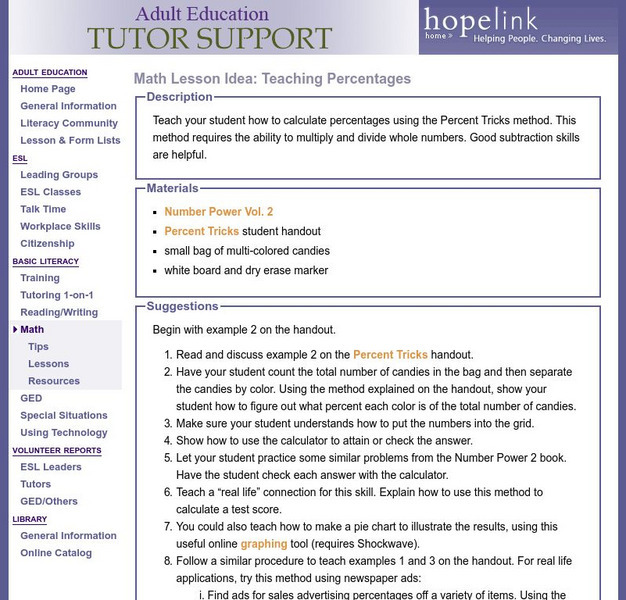Curated OER
Length Lotto-Teacher's Notes
Students convert metric units of length, specifically meters, centimeters, and millimeters. In this lesson of converting measurements, students participate in various games which require them to put the measurements in order or convert...
Curated OER
Using Real-Data from North Dakota to Study Place Value, Rounding, Estimation, Fractions, and Percents
For this real-data worksheet, learners use data from the 2008 Census Bureau to answer eight questions divided into four activities. The topics covered include: place value, rounding, estimation, fractions, and percents.
Curated OER
Infectious Diseases: Hepatitis B and Tuberculosis
Students discover the different sources of pathogens that cause diseases. In this health science activity, students explore different ways to treat infections. They create a persuasive pamphlet on their position on vaccination.
Curated OER
How Do Dinosaurs Measure Up?
Students measure and draw to scale, a representation of a dinosaur to practice math skills.
Curated OER
Solutions or Impossibilities? HIV Prevention for African Children
Students analyze maps for clues as to why students and mothers in both urban and rural areas of Africa may not fight HIV the same way as those in wealthier countries. They write an essay outlining solutions to the AIDS epidemic.
Curated OER
You Are What You Eat
Learners evaluate their eating habits, focusing on the ways in which one assesses whether or not his or her diet is nutritious. They work in small groups to design a menu for a healthy lunch and write a paragraph justifying their choices.
Curated OER
Weight Training
Students conduct a class-wide survey collecting, compiling, and analyzing data about fitness, weight loss, and body image issues. They analyze the relationship between exercise and diet in weight control.
Curated OER
Epidemic Proportions
Young scholars research epidemics that have devastated world population at various points in history. They share and calculate statistics obtained in their research and develop graphs comparing and contrasting how different epidemics...
Curated OER
Mummy Dearest
Students assess what environmental conditions best contribute to preservation and mummification by participating in a multi-day 'apple mummification' lab.
Curated OER
Where Will You Be November 2?
Students consider reasons why many Americans do not vote in national elections and explore the increase in new registered voters. They research a particular demographic and create an advertisement encouraging members of that group to vote.
Curated OER
Create the Ideal City
Students examine the significance of city planning. They analyze maps, develop a crossword puzzle using vocabulary terms, and create a diagram of an ideal city and describe the features that make it healthy for the economy, the...
Curated OER
Statistical Drug Abuse and Adolescents in the U.S.A.
Students examine statistics of teenagers using alcohol and marijuana. In groups, they brainstorm the reasons why they believe usage is higher than in years past. As a class, they role-play different roles in scenerios to help them...
Curated OER
African American Poetry: Songs of Protest and Pride
Students are introduced to various time periods in history in which African Americans wrote songs and poetry to cope. In groups, they travel between different stations to listen or read poems and music from the Civil War period, Civil...
Curated OER
One Size Fits All?
Students describe the differences between an estimate and a guess. They create reasonable estimates based on comparison and activities. Students explain how estimation is helpful in showing the relative size on a scale. They also...
Curated OER
Cleaning Air with Balloons
Learners examine how a pollutant recovery method functions in cleaning industrial air pollution. They listen to a teacher-led discussion, conduct an experiment with balloons, static electricity, and pepper, and observe and record the...
Curated OER
Count The Letters
Students perform activities involving ratios, proportions and percents. Given a newspaper article, groups of students count the number of letters in a given area. They use calculators and data collected to construct a pie chart and bar...
Curated OER
Balance of Power
Students examine the number of women in the United States Senate. After reading an article, they discover Hillary Clinton's possible bid for the presidential nomination for the Democratic party. In groups, they research the lives and...
Curated OER
Recycling Statistics
In this environment worksheet, students look for the answers to the environmental impact of recycling in Great Britain with the statistics from the pie graph.
Curated OER
Testing Fats in Food
Students consider the fats found in foods. In this science lesson plan, students test the presence of fat in foods and become more aware of their daily diets.
Curated OER
The World is a Village
Students observe Americans through the eyes of the world. In this human population lesson, students utilize the Internet to view the World Pop Clock and follow the world's population by the minute. Students predict what the...
Curated OER
From Farm to Table
It's important for students to understand where our food comes from and the environmental implications of agriculture.
Hopelink
Hopelink: Teaching Percentages
Students can brush up on percentage skills with this lesson and calculate percentages using the "Percent Tricks method." For students to successfully use this method, they must have the ability to multiply and divide whole numbers.
TeachEngineering
Teach Engineering: Decimals, Fractions & Percentages
Students learn about and practice converting between fractions, decimals and percentages. Using a LEGO MINDSTORMS NXT robot and a touch sensor, each group inputs a fraction of its choosing. Team members convert this same fraction into a...
Other
Active Maths Limited: Fractions, Decimals & Percentages
Here are two excellent, interactive, teaching resources that visually demonstrate equivalent fractions, decimals and percentages.























